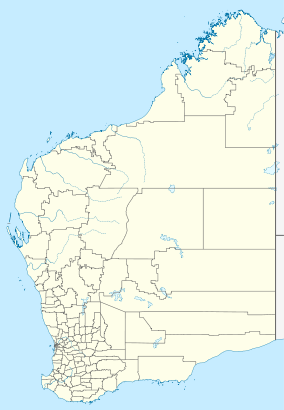- Yanchep National Park
-
Yanchep National Park IUCN Category II (National Park)Nearest city Perth Coordinates 31°33′38″S 115°41′27″E / 31.56056°S 115.69083°ECoordinates: 31°33′38″S 115°41′27″E / 31.56056°S 115.69083°E Area 2,876 ha (7,110 acres)[1] Established 1957 Governing body Department of Environment and Conservation Official website Yanchep is a national park in Western Australia (Australia), 42 kilometres (26 mi) north of Perth. The park is noted for its caves, native bush and koala colonies. It also offers cultural educational programmes offered in partnership with the local Nyoongar aboriginal people.
Contents
History
The area was inhabited and was a noted hunting site for thousands of years by Indigenous Australians prior to the arrival of Europeans. The tribal name for the park is Nyanyi-Yandjip named after the reeds and lake which were thought to resemble the hairy mane of the dreamtime creature the Waugul.
The word Yanchep is derived from Yandjip or Yanget which is the aboriginal name for the local bulrush reed found fringing the lakes in the area.[2]
The first European visitor arrived in 1834 when John Butler, a farmer, came in search of his lost cattle and noted the presence of the lakes, wetlands and plentiful game.[3] While in the area Butler was geeted by the men of the Yellagonga peoples who inhabited the area. Lieutenant George Grey travelled through the area in 1838 and made note of the remarkable caves he found in the area.[4]
Surveyor John Septimus Roe and Governor John Hutt visited the caves in the park in 1841.
A road survey was conducted near Loch McNess in 1862 and later in 1865 a stock route was built through the area that was later used by drovers.
The first settler to arrive in the area was Henry White who arrived in 1901 and built his house near the north west shore of Yonderup Lake, he was later appointed as a caretaker and guide in 1903.
Flora and fauna
The park is home to a diverse rangle of flora and fauna. Trees such as Banksias, Paperbark, Tuart, Marri, Sheoak and stunted Jarrah are found in the woodland areas. Wildflowers including Parrot Bush, Yanchep Rose, Catspaw and Kangaroo paw are also found.[5]
The park provides habitat for several species of native mammal, including the Quenda, Western Grey Kangaroo and Black-glove Wallaby. It lies within the Northern Swan Coastal Plain Important Bird Area, so identified by BirdLife International because of its importance in supporting several thousand Short-billed Black Cockatoos during the non-breeding season.[6]
See also
References
- ^ Department of Environment and Conservation 2009–2010 Annual Report. Department of Environment and Conservation. 2010. pp. 48. ISSN 1835-114X. http://www.dec.wa.gov.au/content/view/6139/2345/.
- ^ "Philosophy of National Parks". http://adt.ecu.edu.au/adt-public/adt-ECU2008.0012/02Venn,%20Darren_ch.1-4.pdf. Retrieved 2010-05-16.
- ^ "Yanchep National Park Management Plan 1989-1999". http://www.dec.wa.gov.au/pdf/nature/management/yanchep_np.pdf. Retrieved 2010-09-26.
- ^ "City of Wanneroo -A brief history". http://www.wanneroo.wa.gov.au/3/93/1/history_of_wanneroo.pm. Retrieved 2010-05-16.
- ^ "Western Australia - Yanchep National Park". http://www.westernaustralia.com/en/Pages/Attraction.aspx?n=Yanchep_National_Park&pid=9001631. Retrieved 2010-05-16.
- ^ BirdLife International (2011) Important Bird Areas factsheet: Northern Swan Coastal Plain. Downloaded from http://www.birdlife.org on 2011-09-03.
External links
National parks of Western Australia Alexander Morrison · Avon Valley · Badgingarra · Beedelup · Beelu · Boorabbin · Brockman · Cape Arid · Cape Le Grand · Cape Range · Collier Range · D’Entrecasteaux · Drovers Cave · Drysdale River · Eucla · Fitzgerald River · Francois Peron · Frank Hann · Geikie Gorge · Gloucester · Goongarrie · Gooseberry Hill · Greenmount · Gull Rock · Hassell · Hidden Valley · John Forrest · Kalamunda · Kalbarri · Karijini · Karlamilyi · Kennedy Range · Leeuwin-Naturaliste · Lesmurdie Falls · Lesueur · Millstream-Chichester · Mirima · Mitchell River · Moore River · Mount Augustus · Mount Frankland · Nambung · Neerabup · Peak Charles · Porongurup · Purnululu · Rudall River · Scott · Serpentine · Shannon · Sir James Mitchell · Stirling Range · Stokes · Tathra · Torndirrup · Tuart Forest · Tunnel Creek · Walpole-Nornalup · Walyunga · Warren · Watheroo · Waychinicup · West Cape Howe · William Bay · Windjana Gorge · Wolfe Creek Meteorite Crater · Yalgorup · YanchepCategories:- IUCN Category II
- National parks of Western Australia
- Protected areas established in 1957
- Swan Coastal Plain
- Wanneroo wetlands
- Important Bird Areas of Australia
Wikimedia Foundation. 2010.


